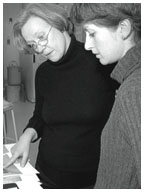President Tilghman with her former graduate student, Ekaterina Semenova *03. |
Grads and Undergrads: Partners in Education
This past June I attended the Ph.D. thesis defense of my 18th—and for the time being, last—Princeton graduate student in molecular biology, David Katz. As it is for many Princeton faculty members, this was a bittersweet occasion for me. It was a celebration of the coming-of-age of a young scholar who had successfully completed his research and fulfilled his teaching assignments, but it also meant taking leave of a student with whom I had worked happily and closely for the past six years. This milestone in my own teaching career has led me to reflect on the many ways in which Princeton can benefit from the close interplay that exists on our campus between graduate and under- graduate students.
Although Woodrow Wilson lost his struggle to locate the Graduate College in the mainstream of undergraduate life, his vision of a University community in which all minds could be nourished by frequent interaction has endured, and in the future will be enhanced. This cross-fertilization is especially evident in the sciences and engineering, where undergraduate and graduate students share a physical space—the laboratory. When I think of my own laboratory as it was three years ago, I recall a bustling, over-crowded, and noisy crucible, where undergraduate and graduate students shared bench space and, together, discussed and planned their research projects. The laboratory was an intense place in which educational growth was happening at every hour of the day.
When David Katz precepted in the introductory molecular biology course MOL 214, he encountered Harrison Gabel ’01, who so impressed him that he recruited Harrison to the laboratory to pursue his senior thesis. The two worked closely together, the slightly older graduate student providing direction to the promising undergraduate, who in turn educated the graduate student by continually asking probing questions. In the process, David also acquired invaluable training as a mentor.
While the educational experience of graduate and undergraduate students in other disciplines at Princeton is necessarily different, these kinds of learning exchanges take place in the humanities and social sciences as well. The University Center for Human Values, for example, conducts a very popular seminar that is attended by both undergraduate and graduate students. In the Woodrow Wilson School, the policy task forces that enable juniors to focus on and propose solutions to a wide range of contemporary problems in public and international affairs are frequently augmented by “graduate consultants.” These graduate students conduct research and play a crucial role in discussing and drafting the recommendations of their respective task forces—truly a fruitful partnership for everyone concerned.
We are also taking steps to ensure that the ties between graduate and undergraduate students are reinforced in our residential colleges. At the present time, the masters of these colleges are ably assisted by two resident graduate students who, among other tasks, work closely with the College Councils and the undergraduate resident advisers and minority affairs advisers. Other graduate students participate in college life as graduate fellows, sharing their knowledge and perspectives with undergraduates, primarily through mealtime conversations.
In the fall of 2007, when we inaugurate our four-year residential college system, a team of graduate students—10 in each college—will play both formal and informal roles in the lives of the undergraduates with whom they reside. Some will contribute to the academic life of our colleges by assisting students in need of guidance or tutorials; some will coordinate social and cultural activities such as language tables, where undergraduates can practice their new linguistic skills over dinner; and some will assist college administrators with various aspects of their work.
It is our hope that the presence of graduate students will diversify the residential experience of undergraduates, provide them with responsible and accessible role models, and open doors to unfamiliar fields. For our graduate students, this will be an opportunity to become more fully integrated into the residential life of the campus and to gain experience as peer leaders.
Graduate and undergraduate students rub shoulders in other areas as well: in intramural sports; in a wide range of organizations, stretching from the Princeton Society of Physics Students to the Princeton University Orchestra; and in venues such as the International Center and the Carl A. Fields Center for Equality and Cultural Understanding. Last year, to cite just three examples, Princeton’s undergraduate South Asian Students Association and its graduate student counterpart, Drishti, worked together to bring 15 outstanding South Asian documentaries to campus; the Black Graduate Caucus hosted prospective students of color at Campus Club; and graduate student Elliot Ratzman mentored Sympoh, which bills itself as “Princeton’s most eclectic dance group.” And who can forget last winter’s “This Is Princeton,” which brought both undergraduate and graduate students, as well as other members of our University community, to the stage of Richardson Auditorium for a spectacular evening of music, dance, readings, and even stand-up comedy.
Despite the different parts they play on campus, graduate and undergraduate
students can and do make beautiful music together, and not just under
Michael Pratt’s baton. Through their interactions, they enrich our
community in a way that would, I think, earn Woodrow Wilson’s approbation.![]()


